Hello friends and readers. Last week I touched the third rail and talked about politics. Lost some subscribers. Gained some. Kind of how it works regardless of the topic.
I’m traveling tomorrow and Friday so I opted for some lighter, more positive fare. Those of you who have been Of a Sober Mind know that I write about the influence of music, artists, and bands here frequently.
I hope you get up outta your chair and dance a little jig after this one. Enjoy.
Once upon a time, a child was born
With a light to carry on
Didn't know what he had to be
Had a feelin' he was bound to see
So the streets he fled to shine
In a world of a different kind
As he yearn, so he learn
Yea-ah-yo-no-no, yeah yeah
Stop! Look what's behind you
Fame and love's gon' find you
We're just here to remind you
Yearn and learn is what you do
Ha, he just felt so, good inside
Watchin' people come alive (ow)
Throbbin' rhythm and it stirs your soul
Melodies of joy unfold
Autobiographical lyrics from Yearnin’ Learnin’ 1975.
Maurice White, the smooth crooner at the front of the band he founded, Earth, Wind, and Fire, died peacefully in his sleep of complications from Parkinsons disease on the morning of February 4th, 2016 at the age of 74.
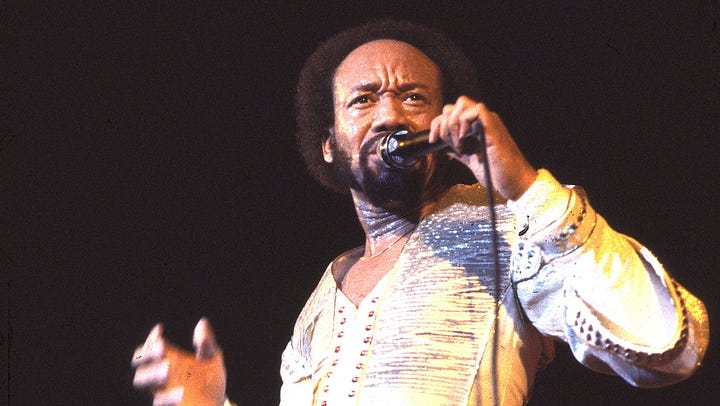
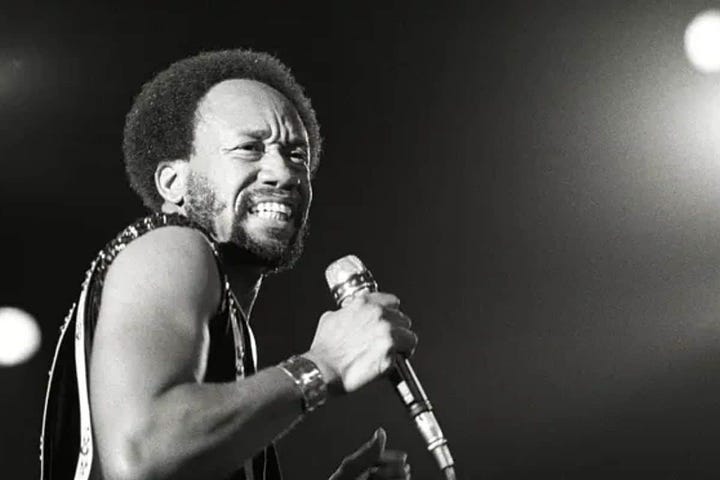
When I first discovered EWF in high school I was smitten. The combination of spiritual and positive lyrics, the wild horn arrangements, the showmanship on stage, and the amazing voice harmonies reeled my soul in and never let it go. The hook was set. Little did I know that 30 years hence I would finally give up the fight against my addictions and enter a life of sobriety and recovery. This is part of the reason the spirituality of EWF resonates with me still.
It isn’t just a listening experience for me—it’s more visceral than that—I simply cannot sit still to their music. The reaction starts in my hands and feet, moves to my gut, up my esophagus into my throat, simultaneously filling my bursting heart with blood, which pumps up through a throbbing carotid into the synapses of my brain. Suddenly my entire body is moving uncontrollably.
Like many fans of the band, the release of That’s Way of the World’s in 1975 was my first real taste. Hard to believe it was the seventh album released by the prolific band, and their fifth since legendary producer Clive Davis had taken over their contract in 1972. Likewise—but contrary to my own experience—many Steely Dan fans never discovered that band until their 6th album Aja.
Earth Wind and Fire did modestly chart their first album releases but mostly on black radio stations. It was Davis—and a movie soundtrack of the same name for Mario Van Peebles—that exposed EWF to a mainstream, cross-genre audience with That’s the Way of the World.

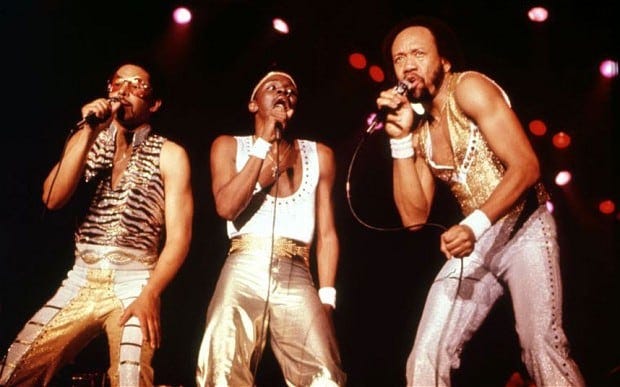

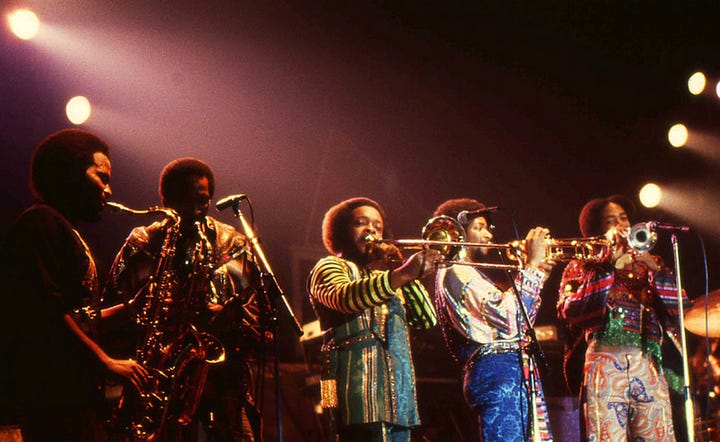
Immediately upon inspection, the lyrics of the songs written by Maurice White, Phillip Bailey, Verdine White, Al McKay, Charles Stepney, and Larry Dunn, are about the human soul, the power of the universe, the magic of music, and love. Nearly all EWF songs are listed as collaborative writing efforts. But it was White that made EWF a reality in the first place and was their locomotion. More on that later.
Fancying myself as a singer in those days—having played the male lead Curly in our high school’s production of Oklahoma—I simply wanted to be Maurice White. His silky tenor/baritone so matched my own range that I was constantly banging around singing Shining Star, Happy Feelin, Yearnin’ Learnin,’ Reasons, and That’s the Way of the World.
Having a deep personal love of the band, yet being a poor college student, I was determined nonetheless to attend my first EWF concert announced for SMU’s Moody Coliseum in 1977. Moody was, and still is the on-campus arena at SMU—and the home of the Mustangs basketball program and many other indoor sports and entertainment. The tickets were—even at that time—out of reach for my budget. My friends Rick and Chip—both recent converts to EWF—began scheming a way to get in front of the band on that night.
The SMU campus—according to some adventurous friends of ours on the swimming and diving team—was laced with underground utility tunnels. They had pointed out the grated entry points throughout campus and described having used the tunnels to sneak into the Natatorium and Moody Coliseum several times. All it took was a pair of boltcutters for the Master lock on the grate, a flashlight, and some liquid courage. We were easy to persuade.
On the night of the sold-out show, we began our journey from a relatively discreet location behind the freshman quadrangle. Once in the tunnels—which were dry and lit and lined with pipes and cables—we had to sniff out the proper direction to get us to—and inside—Moody. Having no map, we relied on general directional instinct. We had started out only a couple hundred yards away as the crow flies, but the cross-hatched tunnels didn’t have any coliseum this way signs to mark our way. The journey took 70 minutes of walking down dead-ends, and a lot of staring up out of a grate at points across the campus far from our desired destination.
Suddenly we began to hear the thumping of amplified music in the distance. We wound up in a small utility room which dead-ended in a tall dirt wall with a three-foot gap at the top. From that gap boomed the music. We boosted one another up and over, landing on the cement floor in the dark on the other side. Now covered in dirt, buzzed from our tunnel journey essentials of smoke and drink, and unsure of what to do next, we pulled out the one Sears flashlight we had smuggled in our pants. A double utility door stood at one end. No other way to go otherwise back up and over the dirt wall behind us.
We opened the door carefully and we found ourselves on the lower concourse of Moody Coliseum. Slipping into the stream of people, and quickly wiping the remaining dirt from our jeans and t-shirts, we spotted no badges or uniforms.
We were in!
All seats were assigned at Moody—there was no general admission. That said, anyone who has ever attended an Earth Wind and Fire concert, knows that everyone stands and dances for most of the show. Before we knew it, we were in front of the stage looking up at the theatrics of Maurice and the band. It was the first of many EWF shows in the last 40 years, and certainly a seminal one.
My roommate Andy—still one of my closest friends to this day—and I used Earth Wind and Fire ritually each weekend evening to pump up for going out.
Back to the band. The accolades are well-known. Earth Wind and Fire has sold nearly 100 million records, making them one of the best-selling bands of all time.
—6 Grammys out of 17 nominations
—Grammy Lifetime Achievement Award
—Rock n’ Roll Hall of Fame
—Vocal Group Hall of Fame
—NAACP Image Award Hall of Fame
—BET Lifetime Achievement Award
—Hollywood Walk of Fame
—Soul Train Legend Award
—Kennedy Center Honor Roll
—4 American Music Awards
—Honorary Doctorates at the Berklee College of Music
Dozens of producers, songwriters, and performers credit Earth Wind and Fire as a major influence.
Maurice White grew up in the Foote Homes projects in South Memphis. Childhood friends included David Porter and Booker T. Jones, with whom he formed a band at Booker T. Washington HS. He has described the time living with his father then as poor of things but not of spirit. Frequently traveling to Chicago to visit his mother and stepfather, Maurice eventually moved to Chi-town as a teen. Playing as an underage drummer in club gigs, White also studied at the Chicago Conservatory of Music. He became a studio musician at Chicago’s Chess Records, backing up such acts as Buddy Guy, Etta James, Chuck Berry, Junior Wells, and Muddy Waters. It was here that he was introduced to jazzman Ramsey Lewis, quickly joining his jazz trio as the drummer. After a couple of years there, White joined two contemporaries and formed the Salty Peppers in 1969. The band mostly wrote commercials for radio and television but had modest Midwest radio success before Maurice White moved to Los Angeles, taking one of the Peppers—Wade Flemons with him.
Maurice, pronounced with two syllables—the second one ending in a drawn-out pop of eeeeece was the man’s name—never Mo. He changed the name of the band to Earth Wind and Fire. Legend has it that the name reflected White’s Sagittarius earth elements. On the outside, Maurice White was the epitome of cool and smooth, but with a constant molten core.
Over the decades, there have been dozens of members of Earth Wind and Fire. In a TuneTag worthy of
the links across all aspects of contemporary music are legion. Ronnie Laws played Saxaphone with EWF prior to launching his solo career. Daniel de los Reyes played drums prior to joining Chicago and now the Zac Brown Band. Jessica Cleaves also sang with Friends of Distinction and Parliament Funk. The legendary 5-member EWF horn section, The Phenix Horns, the soaring backbone of many Earth Wind and Fire hits, would also find fame playing for Genesis and Phil Collins. Singer and percussionist Sonny Emory went on to play with the B52s, Eric Clapton, Lee Ritenour, and joined Bruce Hornsby’s band for many years.But the backbone of the band was always its founding members White, his Denver buddy Phillip Bailey—he of the four-octave vocal range made famous by the hit Reasons—younger brother bassist Verdine White, and Ralph Johnson.
Twenty-two studio albums. A dozen live and compilation albums. Hundreds of definitive playlists across the many streaming platforms. Dozens of songs across rap and R&B that sample EWF. A profound impact on the world of music.
Of all of their hits across time, the one that resonates the most in my life to this very day is Sing A Song—a hit released on the Gratitude album (go figure) in 1975.
Complex, layered vocals, a driving and infectious dance beat, and the high-octave Phenix Horns arrangement. White’s precise but spontaneous vocal lead mixed with Bailey’s soaring falsetto. And those simple and powerful lyrics—so necessary in today’s world:
When you feel down and out
Sing a song, it'll make your day, yeah, yeah
Here's a time to shout
Sing a song, it'll make a way
Sometimes it's hard to care
Sing a song, it'll make your day
A smile so hard to bear
Sing a song, it'll make a way
Sing a song
Sing a song
Sing a song
Sing a song
Bring your heart to believing
Sing a song, it'll make your day, yeah
Life ain't about no retrieving
Sing a song, it'll make a way
Give yourself what you need
Sing a song, it'll make your day
Smile, smile, smile and believe
Sing a song, it'll make a way
Talk to y’all next week. Try to keep a measure of sanity. If politics starts to get you down, remember the words of Maurice White and Earth Wind and Fire.
Open up your heart, let your body find
Freedom in your stride, love and peace of mind, yeah
One more time and we got to say
That the Good Lord gonna make a way
Gonna make a way, gonna make a way
Thanks for reading. I did not do an audio version of this essay. I tried several times, but each time I tried the emotions would rise up and prevent me from finishing.
I’d love to hear your comments.



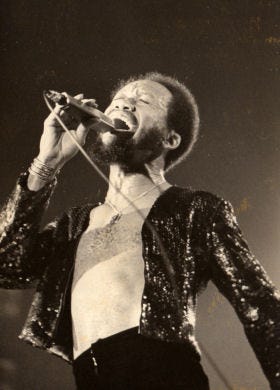
EWF played at my 1984 Grad Nite @ Disneyland! Still memorable 40 years later
When I think of Earth, Wind & Fire, aside from the music, what comes to mind is their excellent style. They were always rocking amazing clothes. The story of your adventure into the concert is the best, I'm so glad you guys made it! Thanks for a great essay Dee. you're right this is a great place to put our attention in the coming weeks.